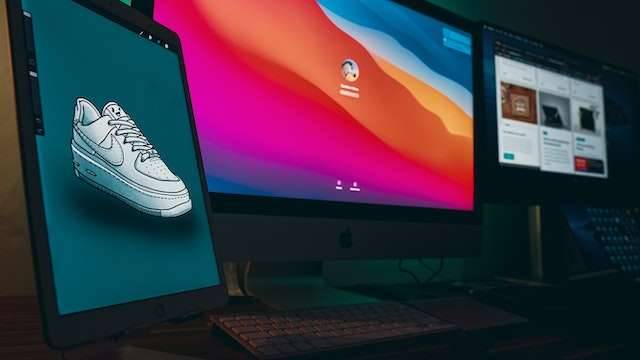Last Updated on April 8, 2024 by Team Experts
As we spend more and more time online, we see a cool blend of artistry and tech. This mix is totally shifting how we create art. A key part of this revamp is the latest catalyst: artificial intelligence, or AI. AI helps with tedious “mechanical” stuff like arranging layouts and working with images.
But there’s more! As technology improves, the possibilities are growing. As AI gets better, the worlds of design and technology are set for more exciting twists and turns. If you want to know how AI is truly changing graphic design, keep reading!
Sparking Creativity with Automation
AI’s arrival in graphic design has started a new time of automation. Planning layouts usually involves lots of repetition and takes heaps of time. Designers often spend hours getting everything just right, resizing images, and adjusting placements. These jobs need careful attention and a lot of hands-on work. This is often done with tools like Adobe’s InDesign or Illustrator. But spending too much time on these tasks can make designers tired and less productive.
The exciting news is that AI layout generators, like Adobe’s Sensei, are changing things. These tools use machine learning to learn a designer’s habits and choices. Over time, they become really good at guessing what the designer wants and making it happen. The result is the clever manipulation of image processing and a whole lot more. Indeed, with our world becoming more and more digitized, we are witnessing how AI is revolutionizing graphic design and reshaping the creative landscape.
Enhancing Precision and Speed with AI
AI’s role in graphic design extends beyond task automation. It’s also a precision-enhancing and speed-boosting tool. AI-powered design platforms like Canva leverage advanced algorithms to execute complex actions with a degree of accuracy and efficiency previously unattainable.
Consider the task of cropping or removing backgrounds from a batch of images. In the past, this process would typically take a seasoned designer up to 30 minutes per image, depending on how complex the project is. Yet today, these tasks can be performed almost instantaneously.
AI tools like the service remove.bg can easily recognize and isolate subjects in an image from their backgrounds, reducing work time to mere seconds. Thanks to AI’s deep learning capabilities— a subset of machine learning that uses multiple-layered neural networks—AI can process and refine imagery at an astonishing speed.
Generative Design: A New Frontier
AI’s presence also provides an exciting gateway to novel design paradigms, such as robust generative design. Here, designers establish specific guidelines and parameters. The AI, fed with these instructions and leveraging sophisticated algorithms founded on principles of genetic evolution, births many design variations.
Rather than starting from scratch, designers morph into curators within this transformative dynamic, inspecting and polishing AI-generated designs.
Several cutting-edge platforms serve as the torchbearers for this radical shift, embodying the enormous potential of generative design. Autodesk’s Dreamcatcher, for instance, can produce designs based on defined objectives and constraints. This enables the balancing of trade-offs and the exploration of the full spectrum of design solutions.
Beyond streamlining workflows, generative design is now pushing the envelope in such areas as branding and logo creation. This trend underscores the paradigm shift in design processes. With AI’s ability to conjure infinite design permutations, it is increasingly seen as an invaluable ally, not a threat.
The Promise and Potential Pitfalls
While AI’s groundbreaking potential is undeniable, its integration into graphic design brings certain challenges. Designers must stay updated with rapidly evolving AI technology, which could prove overwhelming given the rate of advancements. They need to become comfortable with tools like TensorFlow and Keras, programming languages like Python, and principles of neural networks and machine learning.
Moreover, while AI excels at automation, it’s yet to match the nuanced understanding and emotion that human designers bring to their work. Design isn’t solely about aesthetics but also about eliciting an emotional response, an aspect that AI currently lacks.
Charting the Path Ahead
In the foreseeable future, the canvas of graphic design will feature AI and human designers coexisting not as rivals but as co-creators. From simple automation to more complex and collaborative roles, AI will truly become an integral part of the design journey rather than being a mere facilitator.
The challenge ahead is finding a balance between embracing the power of AI and preserving the uniquely human elements of design. Another critical area is the proper training of human designers in AI so that the end result is not their displacement but rather an increase in opportunities in the creative design fields.
As we navigate this brave new world, we can look forward to a landscape that’s as beautiful as it is intelligent and as vibrant as it is efficient. In this space, every element tells a story, every design leaves an imprint, and every artistic challenge is seen as an opportunity for innovation. With AI in our toolbox, the possibilities are infinite.

